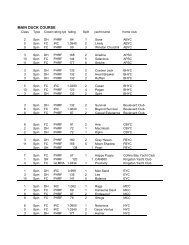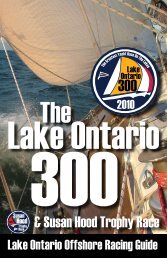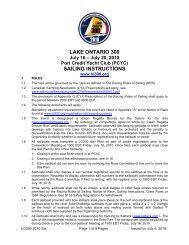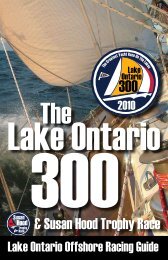You also want an ePaper? Increase the reach of your titles
YUMPU automatically turns print PDFs into web optimized ePapers that Google loves.
Page 58 <strong>Lake</strong> <strong>Ontario</strong> <strong>Offshore</strong> Racing Guide <strong>Lake</strong> <strong>Ontario</strong> <strong>Offshore</strong> Racing Guide Page 59<br />
Meeting the evening prior to the start. The meteorologist noted the instability<br />
of the weather systems which would move through the area on race<br />
day, and emphasized the possibility of some severe weather early in the<br />
event. By most accounts, the weather briefing was one of the best pre-race<br />
reports the participants have had. In spite of this, all were surprised by<br />
the power of the squalls. Most were watching as the systems approached.<br />
Note that the solo fleet started last, and were the first to be effected by the<br />
systems.<br />
After recovering from the passage of the first system, they were able to<br />
observe what some described as “devastation”, “mayhem”, “chaos”, and<br />
“carnage” as the cells caught up with the crewed boats. Most were then<br />
surprised by the second, more powerful system. While the seas never built<br />
to high waves, the surface was described as “boiling white water”.<br />
What precautions were taken?<br />
Several of the participants chose not to set spinnakers at the start even<br />
though the weather conditions were ideal for a downwind spinnaker start.<br />
As the storms approached many were able to get spinnakers down, and<br />
reduce sail area. Those who were caught with too much sail area paid a<br />
price as autopilots were unable to control the boats downwind and allow<br />
further sail reductions. Some admitted to remaining “competitive” too long.<br />
Those who were able to sail through the first squall were overwhelmed by<br />
the second.<br />
What effect did the weather event have on the boat and crew?<br />
While seven of the solo boats had to retire from the event, no one reported<br />
personal injury, and the boats did not suffer structural damage. Sails were<br />
the most common equipment damaged, and the reason most who withdrew<br />
did so. The damage affected mainsails, headsails, and spinnakers.<br />
Those who lost only the spinnaker indicated they would likely have continued<br />
if their mainsails were intact. Only one reported having a spare main,<br />
but most had some alternative headsail.<br />
All of the skippers reported a more cautious spinnaker use as the event<br />
continued. One boat retired due to a damaged radio. One of the current<br />
GLSS members retired, and six of the first-time Challenge participants were<br />
forced to withdraw. All were able to bring their boats safely to port. Those<br />
who were able to continue reported accommodating to damaged lines,<br />
sails, and even a fouled spinnaker halyard that banged and clanked for<br />
most of the race.<br />
All also stayed tuned to the weather reports. While the LO<strong>300</strong> did not<br />
require a periodic call-in, most of the solo fleet did participate using the<br />
same schedule used in other GLSS Challenge events. Ironically, once the<br />
fleet passed the half-way point near Oswego, NY, the winds died leaving<br />
the remaining participants to deal with a light, and no-wind beat westward<br />
for the second half of the event.<br />
Of those who were able to continue, they mentioned their sailing, and<br />
previous Challenge experiences as invaluable in allowing them to react<br />
instinctively, avoid serious damage and continue. Equipment redundancy<br />
and sailing instincts were the most often cited. Some also had back-up<br />
autopilots, although none reported having to use them.<br />
Were you knocked down? Any water through the companionway, and were<br />
the hatch boards in?<br />
Most of the boats were knocked down to some degree, some almost<br />
90 o . All tried to release sheets and halyards, some of which got fouled, or<br />
clutches failed to completely release. In retrospect most of the respondents<br />
indicated they would refit with systems to make sail reduction easier<br />
when sailing downwind. Most had hatch boards in and none had sea water<br />
intrusion, even when knocked down. Those who did not have the boards<br />
in got wet cabins from the rain. Those who had ports open also got wet,<br />
but nothing more. Those boats which were not knocked down attribute it<br />
to having recognized the approaching storms astern, and reducing sail area<br />
in time. They also sensed the need to change from racing mode, to survival<br />
mode early on.<br />
Many who reported being knocked down remained so for some time, being<br />
driven sideways for what seemed like an eternity. Those who were able<br />
to clear fouled lines or sheet stoppers found their boats righted themselves<br />
as designed.<br />
Are the current GLSS gear requirements appropriate?<br />
Most agreed the requirements are adequate, with one emphasizing the<br />
need to revisit the issue. The only new gear recommendation / requirement<br />
mentioned was a personnel or ship’s EPIRB. One crewed multihull was<br />
flipped, but the crew was quickly rescued with the help of other LO<strong>300</strong><br />
participants and the Canadian Coast Guard. While all of the boats had<br />
trackers provided by the Race Committee, many of these cell phone based<br />
devices periodically would lose coverage. This underscores the need to let<br />
those ashore know they cannot be depended upon. The LO<strong>300</strong> shore side<br />
RC did a remarkable job of answering the many calls from concerned family<br />
and friends.<br />
I N N O V A T I V E S A I L I N G S O L U T I O N S










